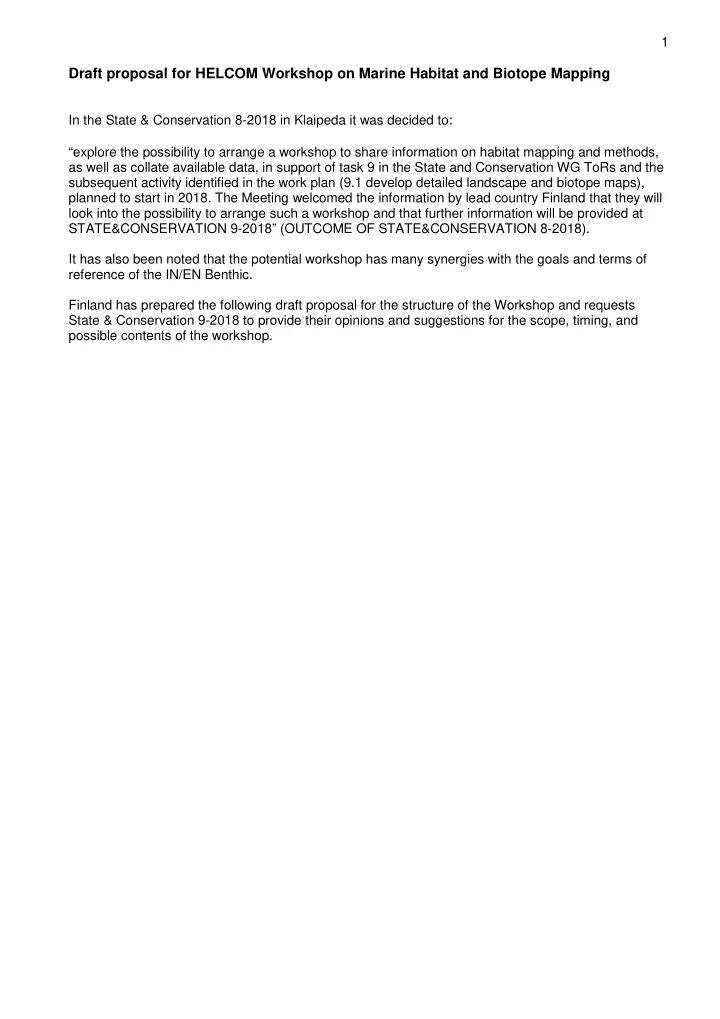

1 Draft proposal for HELCOM Workshop on Marine Habitat and Biotope Mapping In the State & Conservation 8-2018 in Klaipeda it was decided to: “explore the possibility to arrange a workshop to share information on habitat mapping and methods, as well as collate available data, in support of task 9 in the State and Conservation WG ToRs and the subsequent activity identified in the work plan (9.1 develop detailed landscape and biotope maps), planned to start in 2018. The Meeting welcomed the information by lead country Finland that they will look into the possibility to arrange such a workshop and that further information will be provided at STATE&CONSERVATION 9-2018” (OUTCOME OF STATE&CONSERVATION 8-2018). It has also been noted that the potential workshop has many synergies with the goals and terms of reference of the IN/EN Benthic. Finland has prepared the following draft proposal for the structure of the Workshop and requests State & Conservation 9-2018 to provide their opinions and suggestions for the scope, timing, and possible contents of the workshop.
2 HELCOM Workshop on Marine Habitat and Biotope Mapping -Data-driven approach to conservation and sustainable use of marine areas Lead: Finland Contributions from: as agreed in HELCOM State & Conservation Location: tbd Time: tbd Duration: tbd (e.g. 3 days) Background All area-based management tools, e.g. developing a functional network of Marine Protected Areas, identifying areas for Green Infrastructures and Marine Spatial Planning, require field-based knowledge on marine habitats and biotopes. Mapping of habitats, biotopes and biotope complexes is also necessary for assessment of biodiversity, and therefore needed for proper implementation of both HELCOM BSAP and EU MSFD and the Habitats Directive. Mapping and assessment of underwater habitats and biotopes is not a straightforward procedure and requires an array of field based, remote sensing and computational methods. Geologically based habitats can often be localized using standard acoustic (echosounding) methods, and broad-scale seabed habitats have been determined at the European level (https://www.emodnet- seabedhabitats.eu/), and are used as the basis of MSFD “benthic broad habitat types” 1 . EU and HELCOM have however somewhat different approaches to habitat and biotope mapping and classification, (e.g. HELCOM HUBs vs. EUNIS classification and EU Habitats Directive Annex I habitats). Furthermore, practical approaches and methodologies of mapping of species and biotopes are not harmonized in HELCOM member states. This slows down coherent assessment of the state of marine biodiversity, especially in the coastal and shallow water areas of the Baltic Sea, where most of the biodiversity is localized. Aims of the workshop The WS aims to showcase, through practical examples, the whole workflow of mapping and assessment of geo- and biodiversity, from geological and biological mapping through modelling of habitats and species, to final production of maps depicting (i) habitats, (ii) species, as well as (iii) integrated nature values which can be used to identify valuable marine areas in need of conservation and management. The other main goal is to learn from best practices and assess possibilities for harmonization of mapping methods. Developing a common Baltic approach for habitat and biotope mapping enables a data-driven approach to conservation and sustainable use of marine areas, and for determining measures to reach the Good Environmental Status. Expected outcomes of the WS - improved understanding of the methods available for habitat and biotope mapping (HBM) - knowledge on best practices oh HBM in HELCOM member states - analysis of the main knowledge gaps preventing pan-Baltic evaluation of Baltic geo- and biodiversity and marine nature values - a potential platform for harmonization of HBM methods in HELCOM member states - improved possibilities for monitoring and assessment of marine biodiversity, especially in the coastal and shallow water areas, by HELCOM member states 1 Table II in https://eur-lex.europa.eu/legal-content/EN/TXT/PDF/?uri=CELEX:32017D0848&from=EN
3 Themes/modules of the WS 1. Background and theoretical premise: Habitats as study objects – opportunities and challenges 2. Determining goals of HBM; planning field HBM; choosing relevant methods 3. Field mapping of geological formations/habitats (such as reefs etc.) 4. Field mapping of species, communities and biotopes 5. Remote sensing of geological and biological formations – current developments and opportunities (Sentinel 2, LIDAR,…) 6. Habitat and species modelling 7. Creating integrated map and data products describing biodiversity and nature values 8. Usage of habitat maps and other data products in conservation and sustainable use of sea areas Working mode a) Generic lectures b) Presentation of case studies: - VELMU habitat mapping (FI) - VELMU modelling of habitats and species (FI) - MOSAIC framework (SE) - EMODNET c) Facilitated discussions and group work on - Data and knowledge gaps, especially in regard of usage of HBM in conservation and sustainable use of marine areas - Methodological challenges of HBM - Possibilities for cross-border harmonization of HBM
Recommend
More recommend